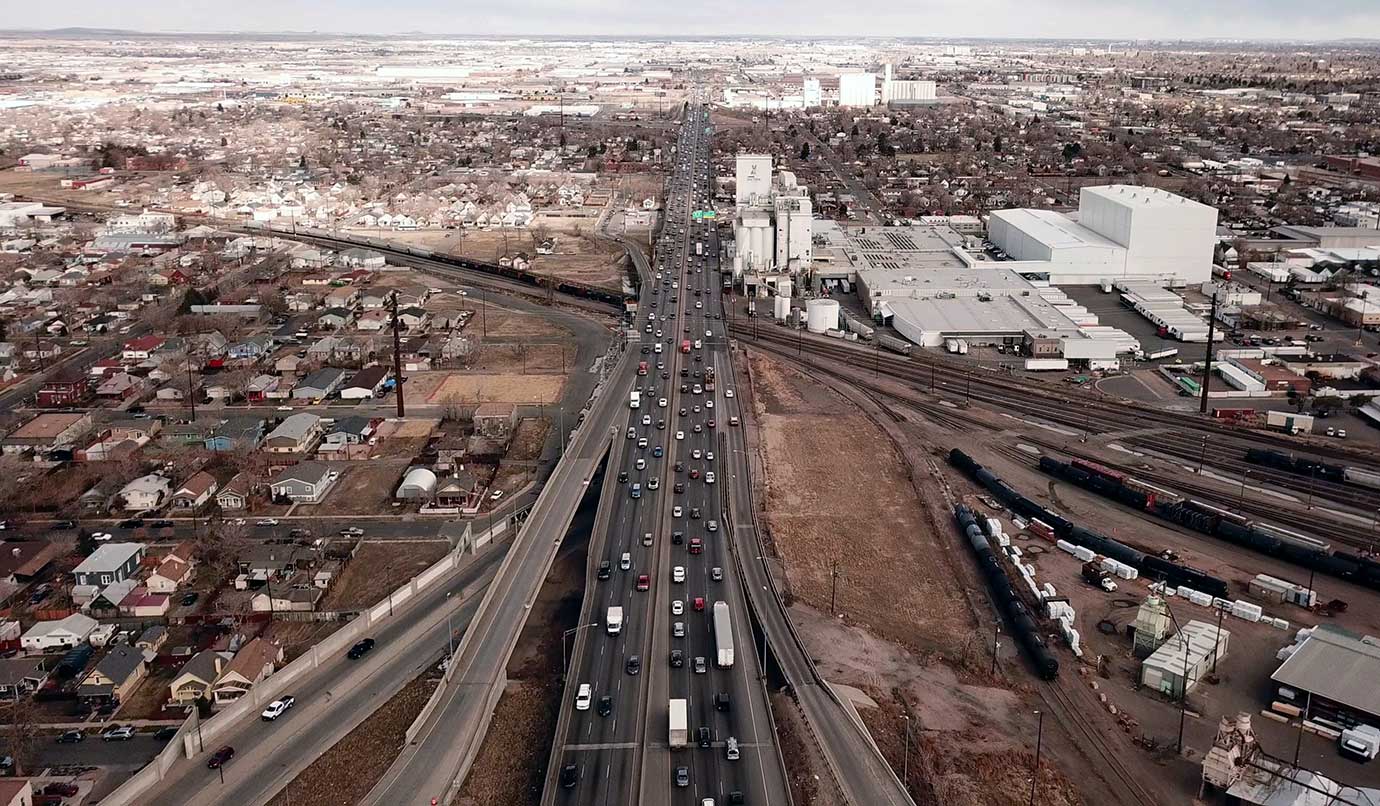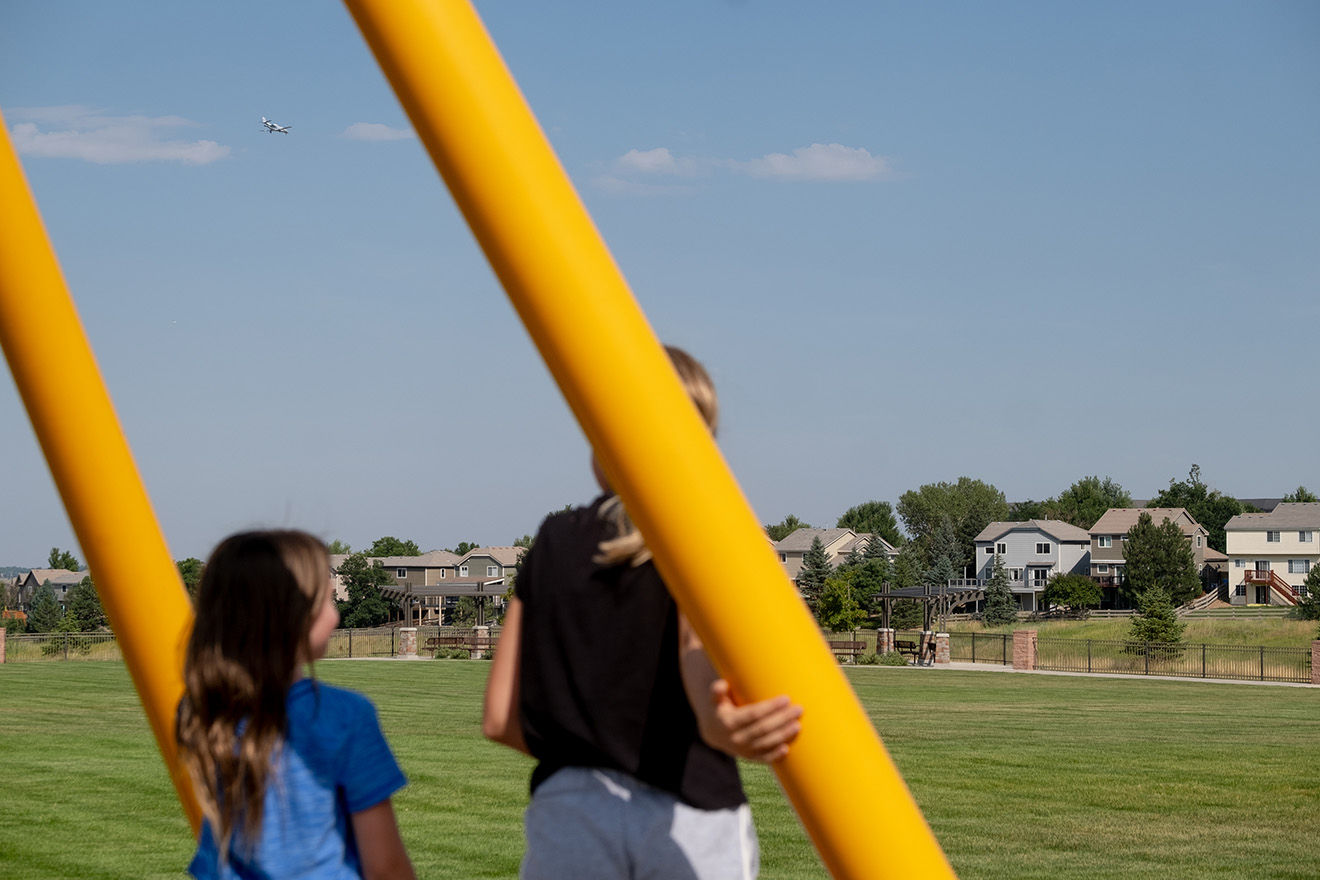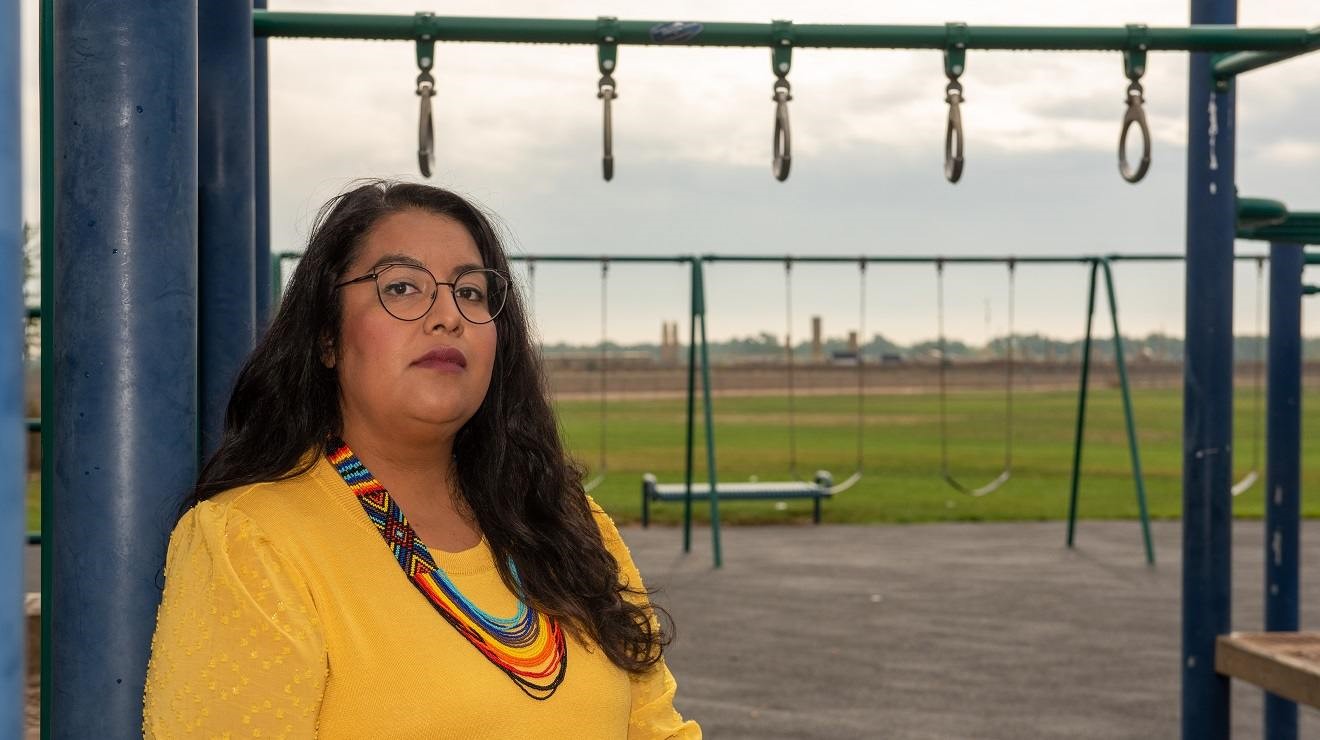Francisca is well aware of all the negative images associated with her stigmatized neighborhood, Elyria-Swansea in north Denver:
- Most polluted zip code in the entire United States.
- Beset on all sides by mega-construction projects bringing in new automobile pollution and stirring up old Superfund pollution.
- Too few fresh groceries, too many roaring trucks, not enough safe sidewalks, sparse green space for the public.
Francisca has plenty of worries of her own. Her daughter suffers from asthma, coughing hard after any time playing outside. The kids come into her bedroom late at night and ask if they’ll be able to afford the rising rent, in a neighborhood where developers want to transform the common adjective from “polluted” to “popular.”
And yet, along with a determined group of women wearing matching pink t-shirts at a recent community-building event, Francisca is fiercely attached to the deep generational connections and quirky, isolated geography of her place. The t-shirts read in Spanish, “Life is more flavorful in Globeville and Elyria-Swansea,” and Francisca, speaking through a translator, wears it with pride.
“They don’t consider us very much,” Francisca said of politicians’ treatment of the two majority-Hispanic neighborhoods. “It’s an industrial zone, they think they have the right” to dump unwanted things here, she said.
“Our children don’t want to leave this neighborhood,” said Francisca, who cleans houses and has lived in Swansea for 18 years. She prefers not to use her last name, still unsure if her activism will somehow result in retribution. “They think we will not raise our voices, but more people are willing. Little by little, we are being seen.”
Community activists have worked hard to amplify the voices for health equity in Globeville and Elyria-Swansea in north Denver, declared by a 2017 series of reports and news articles “the most polluted zip code in America.”
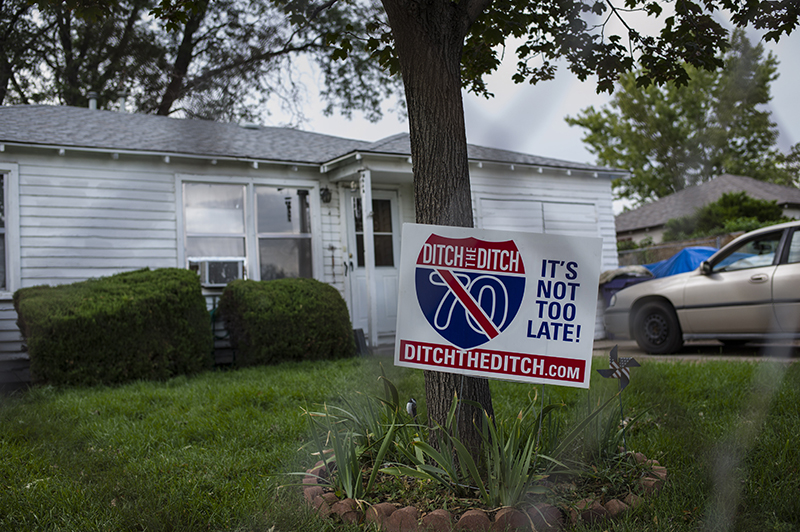
Urban pollution can be a key contributor to poor health outcomes in low-income neighborhoods. A 2016 Colorado Trust review of blood testing data, for example, showed that the highest concentrations of dangerous lead levels in Denver-area youths came from places like Globeville, Elyria-Swansea and Montbello.
Centers for Disease Control and Prevention reports on pollution and health equity describe a “triple jeopardy” for socially disadvantaged groups: First, communities of color and/or with lower incomes are “known to suffer negative health effects from social and behavioral determinants of health (e.g., psychosocial stress, poor nutrition, and inadequate access to health care)”; second, such communities have more exposure to pollution from major highways; and finally, the two factors may multiply each other, so that “the socially disadvantaged groups experience disproportionately larger adverse health effects from exposure to air pollution.”
The activists in Globeville and Elyria-Swansea (often shortened by neighbors as “GES”) remain frustrated by the inexorable advance of disruptive projects like the $1.2 billion “Central 70” interstate expansion.

But they have scored some successes injecting community voices into project oversight. Officials have pledged to reduce pollution and preserve affordable housing in one of Denver’s last under-developed neighborhoods. The activists have made strategic alliances across neighborhood and racial lines for lawsuits against the projects, so far unsuccessful but still in play in the courts.
Local leaders also hope to draw on their strengthened collective voice to seek more outright political power, to better shape the projects of the future.
“We’ve put Globeville-Elyria-Swansea on the map,” said Candi CdeBaca, born and raised three blocks from I-70 and now running for Denver City Council, while leading opposition to the I-70 rebuild neighborhood critics call “the Ditch.” “Five years ago, nobody knew what these communities were, and we’ve brought national and global attention onto what these issues are.”
Activists point out the city itself assessed the health problems in GES, and detailed an action plan on how to improve them. They want project leaders to pay more attention to the 2014 Health Impact Assessment (HIA) for the area, conducted by the Denver Department of Public Health & Environment (DDPHE).
Elyria-Swansea is 84 percent and Globeville is 68 percent Hispanic, compared to 32 percent overall in Denver, the HIA noted. Average household income in Elyria-Swansea is $44,700, and $39,200 in Globeville, compared to Denver’s overall average of $73,100.
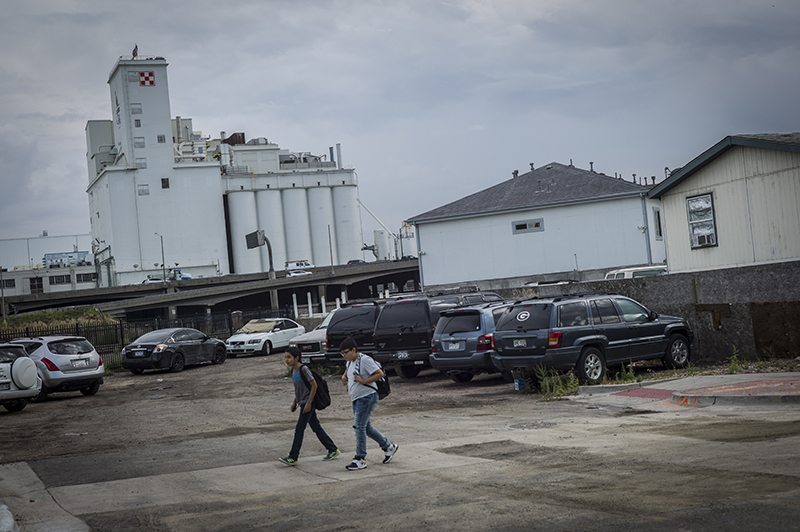
The HIA, meant to guide neighborhood planning, said children in the neighborhoods went to the emergency room for asthma at significantly higher rates than other Denver communities. It found that more than half the adults in the area are overweight or obese, higher than the rest of Denver; that adults are only about half as physically active as the rest of Denver; and that local schoolchildren exercised less than recommended. In addition to many sidewalk gaps and truck-clogged crossings, the area has one of the lowest tree-canopy percentages among Denver neighborhoods, missing chances to ease exercise and clean the air.
The HIA also specifically documented GES residents’ worries about the decades of environmental pollution they constantly hear about, whether heavy metals from a century of metal smelting in Globeville or modern car exhaust.
“Environmental quality is a huge concern” in the area, acknowledged Gretchen Armijo, built environment administrator for DDPHE. “The impacts of poor environmental quality over decades have really resulted in a lot of mental well-being questions” among residents, including worries about their children, Armijo said.
The HIA’s recommendations included more air-pollution test sites; truck rerouting; better sidewalks, bike lanes and lighting; cuts in noise pollution; and connecting cutoff streets in the area’s haphazard road grid.
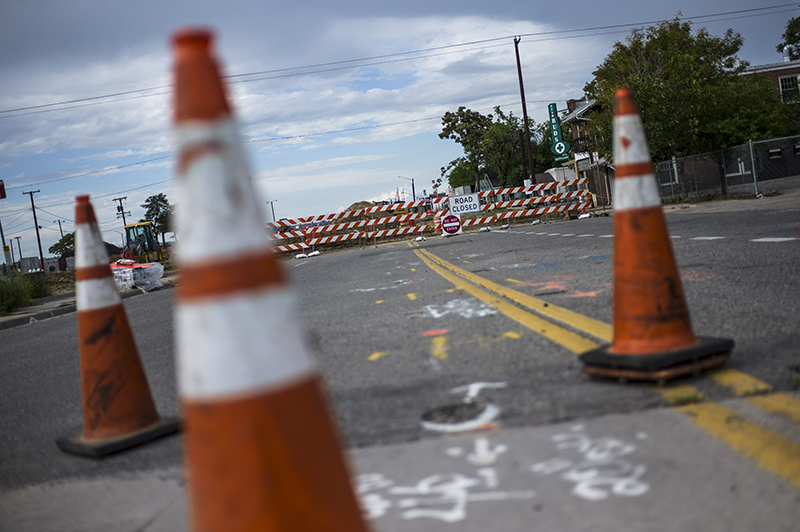
Instead, neighbors believe, the city and state have “rammed through” a doubled highway footprint and drainage projects on Superfund sites, said Drew Dutcher, an architect who lives near I-70.
“The government has a responsibility to protect citizens,” said Dutcher, former head of the Elyria and Swansea Neighborhood Association. “‘It’s all OK’—we’ve heard that many times.”
The recent application for an all-night, everyday noise variance for years of I-70 construction is one example of ignoring the HIA and neighborhood needs, said Nola Miguel, director of the Globeville, Elyria-Swansea Coalition. “The HIA was done, and it was very clear: The city needs to be protecting its residents,” Miguel said.
The list of projects and ongoing nuisances that neighbors mention includes:
- The I-70 rebuild underway is a $1.2 billion project studied for a decade and a half. It will replace 1.8 miles of crumbling viaducts with a below-ground highway from Brighton Boulevard to Colorado Boulevard. It will also triple the footprint of the highway and frontage roads, costing the Colorado Department of Transportation (CDOT) tens of millions to purchase homes and business for demolition. Overall, the project is 10 miles long, and will add a toll lane in each direction. CDOT has said the rebuild will not speed up traffic, but will slow the growth of congestion in the vital airport-to-downtown corridor. One concession to neighbors—some of whom protested that the highway should be rerouted entirely away from GES—is a 4-acre “cap park” over the sunken highway portion at Swansea Elementary School. Proponents say the park will reconnect the northern and southern portions of Elyria-Swansea torn apart by the highway in the 1960s and bring much-needed green space to the underserved neighborhoods. Skeptical activists say the park is a Band-Aid for the overwhelming disruption of the rebuild; and that other neighborhoods would not be enthusiastic, either, about their kids playing on top of traffic exhaust. The latest insult to the neighborhoods was the contractor’s request for overnight noise waivers for three years to speed construction time; on Sept. 6, the city narrowly approved this request for an initial 12-month period, despite significant public opposition.
- The $298 million Platte to Park Hill storm drainage overhaul is tearing up landscapes at Park Hill and City Park golf courses beloved by many neighbors, and disturbing historic pollution sites in areas like the Globeville Landing Outfall, where excess storm water dumps into the South Platte River. Denver’s elected leaders say the drainage work is necessary and long overdue, and show renderings of walkable green space along the 39th Avenue “open channel” drainage, just south of Elyria-Swansea’s southern border at 40th Avenue.
- A billion-dollar overhaul of the National Western Center is underway at the southwest corner of GES, again disturbing historical pollution sites that include decades of unregulated landfill dumping, asbestos and other hazardous debris. The multi-year project comes before the completion of another major neighborhood aggravator, the rebuilding of Brighton Boulevard from downtown to the I-70 viaduct. The Brighton Boulevard projects have slowed traffic and redirected countless trucks and cars on detours through the surrounding neighborhoods.
- The Suncor petroleum refinery in Commerce City, just north of Denver’s border and the GES neighborhoods, has repeatedly been reviewed and/or fined by state health officials for emissions of potentially hazardous gases. In one of the most recent community protests last spring, state officials came under fire for setting limits for releases of hydrogen cyanide that were even higher than Suncor had already been emitting. The neighborhoods joined with environmental justice groups to petition the U.S. Environmental Protection Agency (EPA) to require the state to set tighter limits.
- Noise pollution, an omnipresent concern in heavily trafficked industrial areas, hit new levels in the past few years during the Regional Transportation District’s A train signal-malfunction fiasco. The commuter rail trains running from Union Station to DIA—through the southern portion of Elyria-Swansea—did not have federally approved gates and signals at traffic crossings. As a result, regulators have been requiring the trains to blast warning signals at high decibels around the clock.
- Mapping of the marijuana industry throughout Denver shows some of the highest concentrations of retail shops in GES, along with warehouse growing operations along the I-70 industrial corridor. Neighbors bring up the smell of the marijuana growing operations surrounding them and the drug’s easy availability, calling it another example of a community targeted by what others don’t want. The Nestle Purina pet food plant at York Street and I-70 often produces another olfactory cloud over the neighborhood.
DDPHE leaders say they can detail testing and mitigation efforts related to many of those issues.
Soil tests are ongoing in the National Western construction and stormwater drainage projects, particularly in the Globeville Landing Outfall area covering over old landfills at the river. Tests have not found leftover arsenic and lead from historic smelting operations, said Andrew Ross, environmental programs manager for the North Denver Cornerstone Collaborative. Instead, they have found small areas of asbestos from past construction debris put in landfills, and are removing more than required to be safe, Ross said.
As part of a larger metro-area pollution measure, air monitoring is being boosted at Swansea Elementary and other schools, and results will be available to the public.
CDOT and the city are both contributing to a dust and noise mitigation effort for just under 300 homes within a block of the I-70 viaduct destruction, and most of the homes have already seen work begun or completed. Residents are getting new storm windows, air conditioning units so that windows can stay shut, energy efficiency audits and makeovers, and more.
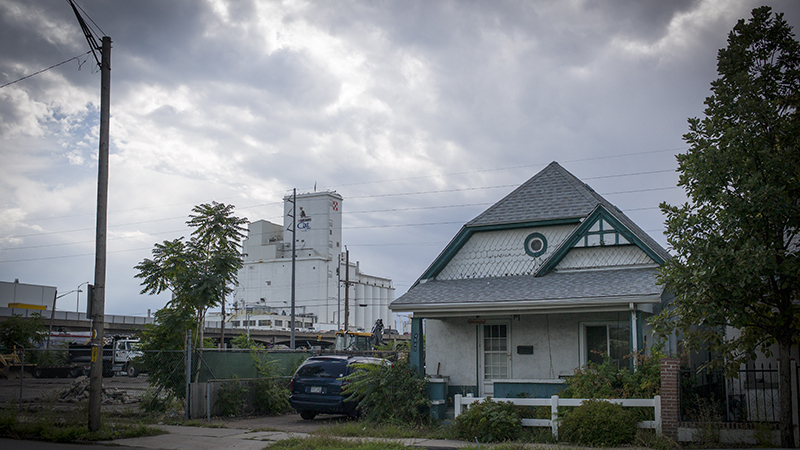
Brenda Lovato is one of those residents, and living less than a block from the expanded highway, she knows she’ll need all the shielding she can get. Her preserved and updated 100-year-old home sits at a stop sign where diesel trucks accelerate every few seconds. Homes at the far end of her block will be torn down for the bigger I-70 footprint. Five years of construction, including the “cap park,” will roar by her new windows.
The upgrades have quieted traffic and helped limit dust, said Lovato, 61. What can never be tamped down entirely, however, are her own worries about the environment. She’s a 37-year resident of the neighborhood, and her late husband had a job on one of the EPA Superfund cleanups, testing soil in backyards and gardens and removing contaminated dirt.
Their own soil was clean, but cancer plagues the family—her husband grew up at 43rd Avenue and Josephine Street, and in his family of 14, four died of cancer and three more cases are diagnosed.
“That’s when I realized something’s not right in this community,” said Lovato, who nevertheless has resisted her children’s invitations to join them in the suburbs.
While listing various mitigation efforts, DDPHE officials say they want GES neighbors to continue to speak up, and even complain more. Ross said more people should use the city’s 3-1-1 system to steer noise, dust and smell complaints to city agencies.
They believe they have listened to concerns, going to neighborhood meetings instead of just inviting neighbors to “official” meetings, working with contractors on anticipating or responding to complaints.
“There’s been a lack of trust over the decades, and we’re doing what we can today to really build those bridges and rebuild that trust for people who want to work with us, and move forward and build a healthier community,” Armijo said.
Groundwork Denver is one nonprofit that has also been trying to bridge the trust gap in GES. The organization is disseminating the expanded air-monitoring results to neighbors, as well as providing support and education for interpreting the findings. For the past 11 years, Groundwork has also worked with GES advocates to claim abandoned open space as official new green space for the neighborhood.
The twisting, multi-block space, surrounding 49th Avenue and Grant Street, should have an official city groundbreaking later this year as Platte Farm Open Space, said Groundwork executive director Cindy Chang.
“The really strong part of the community is they have been there for generations, they know their history, and they are proud of it, proud of being from it,” Chang said of GES and its residents. “They always had the voice, but the attention turned on the community in the last five years or so—for better or worse—has provided an opportunity for people to make their voice heard louder, and for people to pay attention to them in a way they haven’t in the past.”
On the highest-profile project dispute, the I-70 rebuild, a federal judge declined to give opponents an injunction to stop the work. The lawsuits continue, but some advocates are increasing emphasis on the issues of housing displacement and gentrification.
Improvements and mitigation efforts touted by the city and state will be meaningless if rents, housing prices and property taxes rise so high that few current residents can stay to benefit, activists said.
“It has an emotional toll on health when we see the neighborhood is under construction, and we see it changing, and it may not necessarily be for us in the end,” said Liliana Flores Amaro, a resident who was raised in the neighborhood and also sits on the community advisory group for the National Western Complex. “People wonder if they’re going to be able to stay in the neighborhood, and we’ve already seen displacement.”

Photo by Cyrus McCrimmon for Gary Community Investments, used with permission
Francisca and other activist moms from GES wore their pink shirts on a hot summer day to support a $2 million housing initiative pairing CDOT, Brothers Redevelopment and the Globeville/Elyria-Swansea Affordable Housing Collaborative. The funds will be used to make repairs for those who want to stay but can’t afford renovations, as well as purchase homes outright and put them in a deed-protected trust to remain affordable on resale. Organizers call such efforts key to keeping longtime residents, as well as supporting those who have maintained bonds to the neighborhood over the decades.
“This is a seed that will grow into a permanent effort to create stability in the face of historic disinvestment,” the GES Coalition’s Miguel told the gathered crowd.
Denver Councilman Albus Brooks, whose District 9 includes GES as well as downtown, lives six blocks from I-70. He came to the podium of the housing announcement and praised the initiative, pledging to work with the city and other groups to make the fund bigger.
Brooks said in a later interview that the original routing of I-70 to split the neighborhoods in the 1960s was a major insult with lingering effects. The environmental impacts of the rebuild are “distressing,” he said, but the key is to take advantage of CDOT’s mitigation efforts through programs like a local training and hiring requirement for highway construction jobs.
And to defend the community in the future, Brooks said, he is encouraging neighbors to launch an environmental review process from the grassroots that could have the same governance on zoning as a neighborhood plan.
“We want it to be facilitated through the neighborhood and have the city approve it,” Brooks said. Activists “don’t want to see it as a city plan, they want to see it as a true neighborhood plan,” he said. “There’s a lot of trust issues.”
CdeBaca argues current elected officials like Brooks are part of that trust problem with neighbors. Residents tend to lay blame on individual problems like gentrification or I-70 construction or historic pollution, she said.
Yet “what we’ve shown is these are systemic and rooted in policy, and I think that’s an awareness people didn’t have before,” CdeBaca said. “Once people can identify the force that has power in their lives, it’s empowering, and they can move to address it.”
Correction: A previous version of this article misstated the number of blocks Brooks told the author he lives from I-70. Brooks said he lives six blocks from the interstate, not three.
